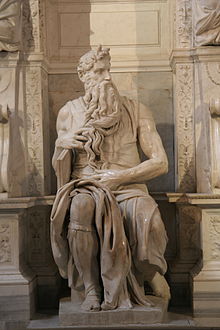San Pietro in Vincoli
41°53′37.94″N 12°29′35.05″E / 41.8938722°N 12.4930694°E


- For other churches of this dedication, see St Peter ad Vincula (disambiguation).
San Pietro in Vincoli (Saint Peter in Chains) is a basilica in Rome, best known for being the home of Michelangelo's magnificent statue of Moses.
History
Also known as the Basilica Eudoxiana, it was first built in 432-440 to house the relic of the chains that bound Saint Peter when he was imprisoned in Jerusalem. According to legend, when the Empress Eudoxia (wife of Emperor Valentinian III) gifted the chains to Pope Leo I, while he compared them to the chains of St. Peter's final imprisonment in the Mamertine Prison in Rome, the two chains miraculously fused together. The chains are kept in a reliquary under the main altar in the basilica.
The basilica underwent several restorations and rebuildings, among them a restoration by Pope Adrian I, rebuilding by Pope Sixtus IV and by Pope Julius II. There was also a renovation in 1875. The front portico, attributed to Baccio Pontelli, was added in 1475. The cloister (1493-1503) has been attributed to Giuliano da Sangallo.
The current Cardinal Priest of the Titulus S. Petri ad vincula is Pío Cardinal Laghi.
Interior
The interior has a nave and two aisles, with three apses divided by antique Doric columns. The aisles are surmounted by cross-vaults, while the nave has an 18th century lacunar ceiling, frescoed in the center by Giovanni Battista Parodi, portraying the Miracle of the Chains (1706).

Michelangelo's Moses (completed 1515), while originally intended as part of a massive 47-statue, free-standing funeral monument for Pope Julius II, became the centerpiece of the Pope's funeral monument and tomb in this, his family's church (della Rovere family).
Moses is depicted with horns, as opposed to "the radiance of the Lord", due to the similarity in the Hebrew between the word for "beams of light" and "horns". This kind of iconographic symbolism was common in early sacred art, and in this case was easier for the sculptor (as sculpting concrete horns is easier than sculpting rays of light) and would have been understood by all who saw it as referring to the radiance of Moses' face; they would not have actually thought that he had horns. [citation needed]
Other art works include two canvases of Saint Augustine and St. Margret by Guercino, the monument of Cardinal Girolamo Agucchi designed by Domenichino (also the painter of a sacristy fresco depicting the Liberation of St. Peter (1604). The altarpiece on the first chapel to the left is a Deposition by Pomarancio. The tomb of Nicolò Cardinal da Cusa (d 1464), with its relief, Cardinal Nicholas before St Peter, is by Andrea Bregno. Painter and sculptor Antonio Pollaiuolo is buried here. Hugh O'Neill, Earl of Tyrone, is also buried in the Church.[1]
References
- Federico Gizzi, Le chiese medievali di Roma, Newton Compton, Rome, 1998.
External links
![]() Media related to San Pietro in Vincoli at Wikimedia Commons
Media related to San Pietro in Vincoli at Wikimedia Commons
